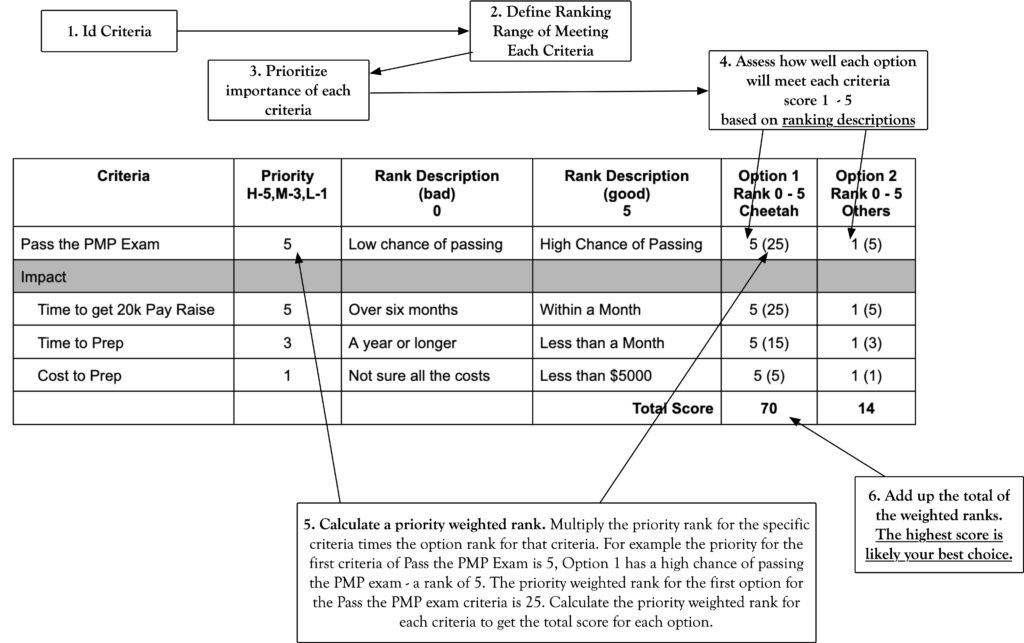Make Better Choices – Three Easy Techniques

The promise of artificial intelligence is that we could ask “Hey Google, should I prioritize scope, schedule or cost” on my bathroom remodel? But, to even be able to ask this question, you’d need to know making tradeoffs between cost, schedule and scope on a project is required.
Using artificial intelligence to help make better choices is only as good as the intelligence asking the question. Just like you need to know what it is you want to prioritize BEFORE you can prioritize, you need to know you can make better choices before you can make better choices.
Here are three techniques to improve the intelligence required to make better choices (especially when relying on artificial intelligence):
1. Delay Gratification – The ability to put off satisfying an immediate desire is required to achieve goals big and small. While the original “marshmallow” study has been debunked (that your later success in life is predicated on the amount of time you can wait before you eat a marshmallow when you are 4), the capability to delay gratification improves with practice. For example, the choice to cut down on sugar so your pants fit better next month. Or the choice to turn off all screens by 9 PM so you can get a good night’s sleep and be well rested for the next day. These require actual, not artificial intelligence (and the capability to follow through). Start paying attention on where you can flex your delayed gratification muscles – the more you do this the easier it becomes to delay gratification. Being able to wait helps avoid making rash choices.
2. Create “rules of thumb” – These are also known as “heuristics.” We all make thousands of decisions every day. Deciding ahead of time with your own “rules” relieves decision fatigue and frees you up to focus on higher-order decisions. For example, when my children were young when shopping they would pester me to get things not on our list. When I started requiring they submit a purchase request for what they wanted to be reviewed on Friday to make a joint decision on Sunday, this stopped the in-the-store pestering. By Friday they had often forgotten what they wanted. For myself, I am a sucker for a good sob story. The scam alert could’ve used me as a poster child. So I set up a rule for myself – I need to spend one minute per dollar required to assess if this makes sense for me to do. So if someone stops by to sell me magazines, and that would be $20 – I tell them to come back in 20 minutes as I need to spend that long thinking about doing this. They never return – problem solved. When you set up your personalized “rules” that fit the choices you don’t want to have to keep making over and over and over it simplifies life. The key is to make sure you make them your rules and not do them to satisfy someone else’s rules.
3. Prioritize your criteria for the choice, BEFORE evaluating your options – Certified Cheetah Leaders learn how to do “opportunity scans” – to evaluate how different opportunities would best meet their specific criteria for making a good choice. The first step with the “opportunity scan” is to identify and then prioritize the choice criteria.
For example, if you want to get Project Management Professional® (PMP®) certified, you need to make a choice on the best way for you to do that. Your criteria would be related to trade-offs with making a choice. The criteria involved in becoming PMP® certified, are related to passing the PMP® exam and doing so with the most favorable impact on your career and family.
You FIRST identify the criteria for making a choice. For each criterion, you create rank descriptions that show how well an option would or would not meet your criteria. Then you prioritize your criteria – since they can’t all be a high priority, you equally divide your criteria between high, medium, and low priorities.
See the table below:
- Identify the criteria for achieving your goal.
- Specify how well (or not) an option would meet each criterion (RANK descriptions)
- Prioritize (H, M, L) the criteria.
- Assess how well each option could meet each specific criteria (score 1 to 5 based on your rank descriptions)
- Calculate a priority-weighted rank (Option rank times criteria priority)
- Total the weighted ranking – the highest score is your best choice
For example:
Option 1 – With Cheetah Exam Prep, there is a high chance of passing the PMP exam. Since that priority for passing the PMP exam was ranked a 5, the weighted rank for the first option (taking Cheetah’s Exam Prep class) on passing the PMP exam would be 25.
Option 2 – With all other approaches to prepping for the PMP exam, these ranked a 1 as there is a low chance of passing the PMP exam with other options (most providers even admit this in their marketing when they say their students can’t pass the test after four days with their program – fewer than 50% of people in many other programs go on to take the actual PMP exam). Option 2’s weighted rank would then be a 5 (priority 5 times option 2’s rank 1 – low chance of passing).

Project Management is about making choices to do projects “right.” Leadership is about making choices to pick the “right” projects. You can improve both by using these three techniques to make better choices.
This is why Cheetah students get bigger and better promotions as they consistently demonstrate they have the skills (and intelligence) to make better choices.
Michelle LaBrosse, PMP, PMI-ACP, CCL, CAC, RYT
Chief Cheetah, www.cheetahlearning,com





“The first thing my boss said when I told him I was interested in getting my PMP certification was that if I was going to do it, he’d heard Cheetah Learning was the best.”